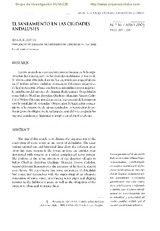El saneamiento en las ciudades andalusíes

Ver/
Autor
Reklaityte, Ieva
Editor
Universidad de Córdoba, Área de ArqueologíaFecha
2005Materia
ArqueologíaObras de infraestructura hispanomusulmanas
METS:
Mostrar el registro METSPREMIS:
Mostrar el registro PREMISMetadatos
Mostrar el registro completo del ítemResumen
The aim of this article is to discuss the organization of the evacuation of waste water in the towns of al-Andalus. The escavations carried out and historical data show the different solutions that were present in the towns, as were the latrines communicated with cesspits or a rather complicated sewer sytem. The analysis of the urban structure of the deserted villages asSaltés (Huelva), Bayyana (Pechina, Almería), Vascos (Toledo), Siyasa (Murcia) demonstrates the presence of latrines in almost every house. We can observe that town authorities of al-Andalus had concerned thernselves with the supervising of an adequate evacuation of waste water, introducing sewer pipes and dikging cesspits in the habitation areas, as well as the obligation of the citizens to clean and maintain them. En este artículo se exponen brevernente las pautas de la orgarnización del saneamiento en las ciudades andalusíes. A través de la información obtenida durante las excavaciones arqueológicas en el ámbito urbano andalusí conocemos diferentes soluciones de la planificación urbana con letrinas asociadas a pozos negros o la instalación del sistema de alcantarillado común. Despoblados como Saltés (Huelva), Bayyana (Pechina, Almería), Vascos (Toledo) o Siyasa (Murcia) nos demuestran la presencia de letrinas en casi la totalidad de viviendas. Observamos la legislación concerniente a la evacuación de aguas residuales, la instalación de pozos negros o la obligación de su limpieza con el fin de asegurar las mejores condiciones higiénico-sanitarias en el ámbito urbano.
